See also
- Fluorescence, emission of light by a substance that has absorbed light or other electromagnetic radiation
Glow-in-the-dark may refer to:
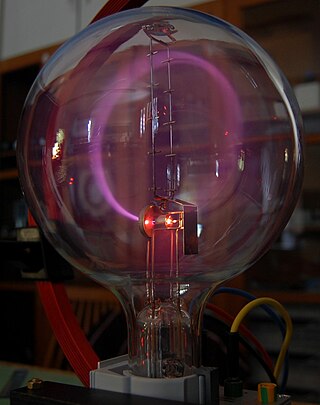
Cathode rays or electron beams (e-beam) are streams of electrons observed in discharge tubes. If an evacuated glass tube is equipped with two electrodes and a voltage is applied, glass behind the positive electrode is observed to glow, due to electrons emitted from the cathode. They were first observed in 1859 by German physicist Julius Plücker and Johann Wilhelm Hittorf, and were named in 1876 by Eugen Goldstein Kathodenstrahlen, or cathode rays. In 1897, British physicist J. J. Thomson showed that cathode rays were composed of a previously unknown negatively charged particle, which was later named the electron. Cathode-ray tubes (CRTs) use a focused beam of electrons deflected by electric or magnetic fields to render an image on a screen.
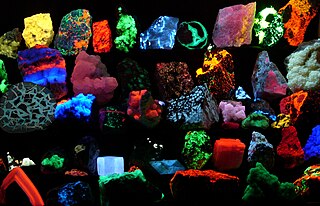
Fluorescence is one of two kinds of emission of light by a substance that has absorbed light or other electromagnetic radiation. When exposed to ultraviolet radiation, many substances will glow (fluoresce) with colored visible light. The color of the light emitted depends on the chemical composition of the substance. Fluorescent materials generally cease to glow nearly immediately when the radiation source stops. This distinguishes them from the other type of light emission, phosphorescence. Phosphorescent materials continue to emit light for some time after the radiation stops.

Luminescence is a spontaneous emission of radiation from an electronically or vibrationally excited species not in thermal equilibrium with its environment. A luminescent object emits cold light in contrast to incandescence, where an object only emits light after heating. Generally, the emission of light is due to the movement of electrons between different energy levels within an atom after excitation by external factors. However, the exact mechanism of light emission in vibrationally excited species is unknown.

Photoluminescence is light emission from any form of matter after the absorption of photons. It is one of many forms of luminescence and is initiated by photoexcitation, hence the prefix photo-. Following excitation, various relaxation processes typically occur in which other photons are re-radiated. Time periods between absorption and emission may vary: ranging from short femtosecond-regime for emission involving free-carrier plasma in inorganic semiconductors up to milliseconds for phosphoresence processes in molecular systems; and under special circumstances delay of emission may even span to minutes or hours.
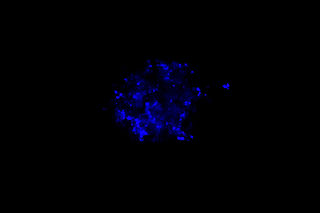
Triboluminescence is a phenomenon in which light is generated when a material is mechanically pulled apart, ripped, scratched, crushed, or rubbed. The phenomenon is not fully understood but appears in most cases to be caused by the separation and reunification of static electric charges, see also triboelectric effect. The term comes from the Greek τρίβειν and the Latin lumen (light). Triboluminescence can be observed when breaking sugar crystals and peeling adhesive tapes.
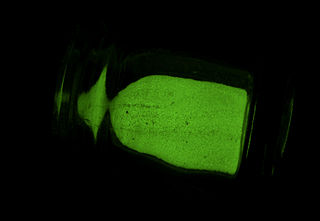
A phosphor is a substance that exhibits the phenomenon of luminescence; it emits light when exposed to some type of radiant energy. The term is used both for fluorescent or phosphorescent substances which glow on exposure to ultraviolet or visible light, and cathodoluminescent substances which glow when struck by an electron beam in a cathode-ray tube.

Chemiluminescence is the emission of light (luminescence) as the result of a chemical reaction, i.e. a chemical reaction results in a flash or glow of light. A standard example of chemiluminescence in the laboratory setting is the luminol test. Here, blood is indicated by luminescence upon contact with iron in hemoglobin. When chemiluminescence takes place in living organisms, the phenomenon is called bioluminescence. A light stick emits light by chemiluminescence.

Phosphorescence is a type of photoluminescence related to fluorescence. When exposed to light (radiation) of a shorter wavelength, a phosphorescent substance will glow, absorbing the light and reemitting it at a longer wavelength. Unlike fluorescence, a phosphorescent material does not immediately reemit the radiation it absorbs. Instead, a phosphorescent material absorbs some of the radiation energy and reemits it for a much longer time after the radiation source is removed.

A blacklight, also called a UV-A light, Wood's lamp, or ultraviolet light, is a lamp that emits long-wave (UV-A) ultraviolet light and very little visible light. One type of lamp has a violet filter material, either on the bulb or in a separate glass filter in the lamp housing, which blocks most visible light and allows through UV, so the lamp has a dim violet glow when operating. Blacklight lamps which have this filter have a lighting industry designation that includes the letters "BLB". This stands for "blacklight blue". A second type of lamp produces ultraviolet but does not have the filter material, so it produces more visible light and has a blue color when operating. These tubes are made for use in "bug zapper" insect traps, and are identified by the industry designation "BL". This stands for "blacklight".
Luminous paint is paint that emits visible light through fluorescence, phosphorescence, or radioluminescence.
Candoluminescence is the light given off by certain materials at elevated temperatures that has an intensity at some wavelengths which can, through chemical action in flames, be higher than the blackbody emission expected from incandescence at the same temperature. The phenomenon is notable in certain transition-metal and rare-earth oxide materials (ceramics) such as zinc oxide, cerium(IV) oxide and thorium dioxide.
Calorescence is a term describing the process whereby matter absorbs infrared radiant energy and emits visible radiant energy in its place. For example, some kinds of flammable gas give off large amounts of radiant heat and very little visible light when burning, and if a piece of metal is placed into such a flame, the metal will become bright red-hot—which is to say the metal absorbs invisible infrared and emits visible radiation. The word calorescence was coined by John Tyndall in 1864 on the model of the word fluorescence which had been coined in 1852. At that time, fluorescence was defined as absorption in the ultraviolet part of the spectrum followed by emission in the visible part of the spectrum. Calorescence was defined complementarily as absorption in the infrared followed by emission in the visible. Earlier, George Stokes had shown the reverse phenomenon: the emission of infrared following the absorption of visible light.

Strontium aluminate is an aluminate compound with the chemical formula SrAl2O4. It is a pale yellow, monoclinic crystalline powder that is odourless and non-flammable. When activated with a suitable dopant, it acts as a photoluminescent phosphor with long persistence of phosphorescence.
Glow or GLOW may refer to:
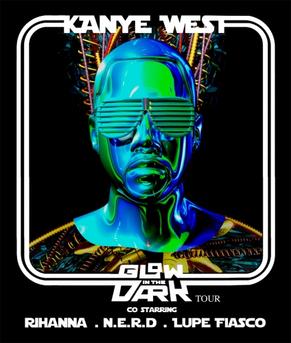
The Glow in the Dark Tour was the third concert tour by American rapper Kanye West, in support of his third studio album, Graduation (2007). West shared the first tour dates across the United Kingdom in September 2007, while he later announced the American leg in January 2008. He engaged in precise tour rehearsals and enlisted Jim Henson's Creature Shop for production of his set, with design handled by Esmeralda Devlin, Martin Phillips, and John McGuire. West mostly performed music from his first three studio albums and incorporated work on later legs from his 2008 album 808s & Heartbreak; the songs were re-arranged by the touring band to have a more melancholy sound. The concerts followed a space opera concept that saw West traveling in his spaceship Jane and then performing on a desolate planet, where he sought more power towards the end. The tour began in London on November 22, 2007, travelling across the United States, South America, Europe, and Oceania until its last show in Brisbane on December 7, 2008. West made a tour stop at the 2008 Bonnaroo Music Festival, although delays faced to his set caused a negative backlash.

Cherenkov radiation is electromagnetic radiation emitted when a charged particle passes through a dielectric medium at a speed greater than the phase velocity of light in that medium. A classic example of Cherenkov radiation is the characteristic blue glow of an underwater nuclear reactor. Its cause is similar to the cause of a sonic boom, the sharp sound heard when faster-than-sound movement occurs. The phenomenon is named after Soviet physicist Pavel Cherenkov.
Photoluminescence excitation is a specific type of photoluminescence and concerns the interaction between electromagnetic radiation and matter. It is used in spectroscopic measurements where the frequency of the excitation light is varied, and the luminescence is monitored at the typical emission frequency of the material being studied. Peaks in the PLE spectra often represent absorption lines of the material. PLE spectroscopy is a useful method to investigate the electronic level structure of materials with low absorption due to the superior signal-to-noise ratio of the method compared to absorption measurements.
In phosphors and scintillators, the activator is the element added as dopant to the crystal of the material to create desired type of nonhomogeneities.

Glow in the Dark is a biographical photo essay about Kanye West's Glow in the Dark Tour published by Rizzoli USA on October 20, 2009. Authored by West, the book was designed by Base and features 400 exclusive images taken on the tour by Australian-American photographer Nabil Elderkin, who had previously directed several of West's music videos.

A luminescent solar concentrator (LSC) is a device for concentrating radiation, solar radiation in particular, to produce electricity. Luminescent solar concentrators operate on the principle of collecting radiation over a large area, converting it by luminescence and directing the generated radiation into relatively small photovoltaic solar cells at the edges.